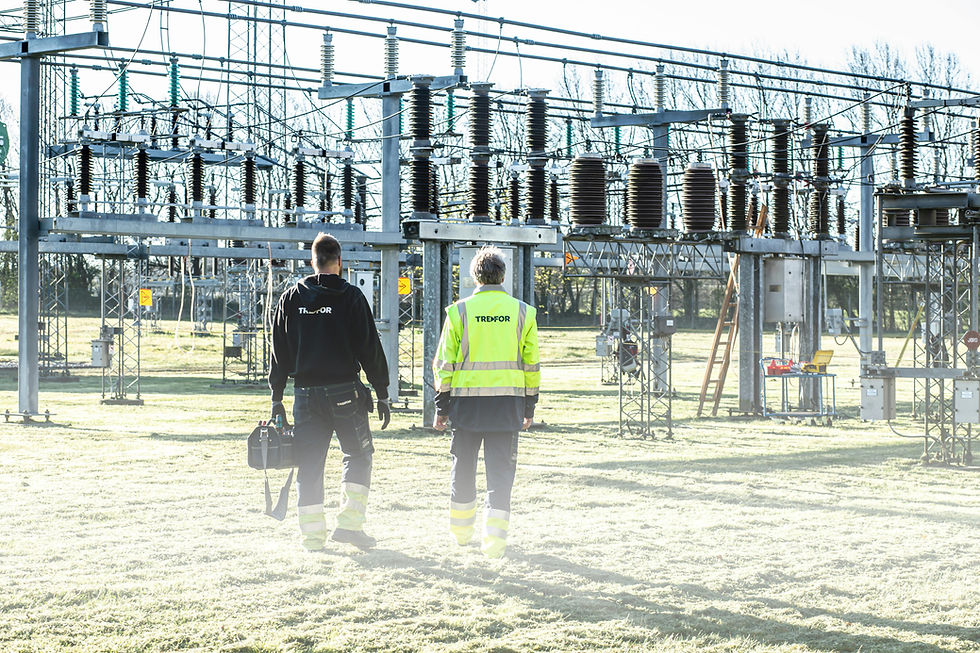Electrical Transformers for Data Centers: Technical Requirements.
- Grupo Edmar

- Aug 20
- 4 min read
Updated: Aug 22
August 20, 2025 - Transformers for Data Centers,
Electrical Transformers for Data Centers: Technical Requirements.
In a world increasingly dependent on information and connectivity, data centers have become the heart of the digital infrastructure. However, behind every server and storage system, there is a carefully designed electrical network that guarantees a constant and reliable power supply. One of the key components in this system is electrical transformers . In this article, we will explore the most important technical requirements that electrical transformers for data centers must meet and how their correct selection impacts operations.
Capacity and Nominal Load.
The first aspect to consider when considering a data center transformer is its load capacity. These types of installations consume large amounts of energy, and any excess demand can cause overheating and failure.
The nominal capacity should be calculated not only for the current load, but also for the projected growth of the data center. This prevents premature replacements and allows for stable long-term operations.
Example: A medium-sized data center that starts with a demand of 500 kVA but plans to double its capacity in three years should install a transformer of at least 1 MVA to avoid expansion problems and ensure operational continuity. Failing that, it's very common for transformers of over 15 MVA to even 100 MVA in high-end projects.

Stability and Energy Capacity.
In a data center, voltage fluctuations and current surges can cause serious damage to equipment. Therefore, the transformer must guarantee a stable, distortion-free power output.
To achieve this, it is recommended that electrical transformers have voltage regulation systems and are capable of filtering electrical harmonics. This ensures that servers, storage equipment, and network systems operate without interruptions.
Poor power quality not only affects performance, but can also reduce equipment lifespan, lead to data loss, and increase maintenance costs.
Refrigeration system.
Heat is one of the biggest enemies of a data center's electrical infrastructure. Transformers, when handling large loads, generate heat that must be properly dissipated to avoid failures.
There are different cooling systems, from dry-type transformers with forced ventilation to oil-immersed transformers with advanced cooling systems. The choice will depend on the location, size of the data center, and operating conditions.
Example: In a data center located in a hot area like Monterrey , a dry transformer with forced ventilation may require additional cooling equipment, while an oil-filled transformer could work more efficiently thanks to its ability to dissipate heat.

Protection and Security.
A failure in an electrical transformer can cause millions of dollars in losses in a data center. Therefore, it's essential to have integrated protection systems, such as overcurrent relays, surge protection devices, and thermal protection devices. Switchgears, are essential for equipment protection.
In addition, the design must comply with physical security measures, avoiding risks to technical personnel. Some data centers implement remote monitoring to detect anomalies and respond before a serious failure occurs.
In critical facilities, electrical safety is non-negotiable, as a single failure can halt operations and affect thousands of users simultaneously.
Continuous Maintenance and Monitoring.
The lifespan of an electrical transformer depends largely on its maintenance. A program of periodic inspections and electrical testing helps prevent failures and extend its lifespan.
Today, many data center power transformers integrate IoT sensors that send real-time data on temperature, humidity, load, and overall health. This enables quick decision-making and continuous operation.
Example: A monitoring system detected an abnormal temperature rise in a transformer, allowing preventive maintenance to be scheduled and avoiding a 48-hour outage at a financial data center.

Impact on Energy Efficiency in Data Center Operations.
In a data center, electrical energy is one of the highest operating costs. Therefore, transformer efficiency is not only a technical issue, but also an economic and environmental one.
A highly efficient electrical transformer reduces energy losses, resulting in less heat generation and less strain on cooling systems. This contributes to meeting sustainability goals and reducing the carbon footprint.
Efficiency improvements may seem small in percentage terms, but they have a significant impact on costs when consumption is constant 24 hours a day, 365 days a year.
Integration with Backup and Redundancy Systems.
A data center can't be shut down by a power outage. Transformers must work in conjunction with backup systems such as generators, UPSs, and redundant distribution networks.
Proper integration ensures that, in the event of a main grid failure, the transformer can receive power from the backup system without dangerous voltage drops.
In mission-critical centers, N+1 or 2N configurations are installed to ensure that even if one transformer fails, another can take the load without interruption.
At Grupo Edmar, we specialize in the design and manufacture of transformers for critical applications such as data centers. Our equipment is designed to offer maximum reliability, efficiency, and safety, adapting to the specific needs of each client. If you're looking for a partner that guarantees the power of your infrastructure and delivers much faster than the current market, we can help you find the ideal solution.




Comments